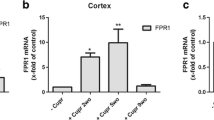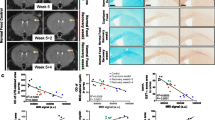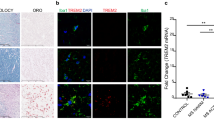Abstract
Multiple sclerosis (MS) is a chronic degenerative disease of the central nervous system that is characterized by myelin abnormalities, oligodendrocyte pathology, and concomitant glia activation. The factors triggering gliosis and demyelination are currently not well characterized. New findings suggest an important role of the innate immune response in the initiation and progression of active demyelinating lesions. Especially during progressive disease, aberrant glia activation rather than the invasion of peripheral immune cells is accountable for progressive neuronal injury. The innate immune response can be induced by pathogen-associated or danger-associated molecular patterns, which are identified by pattern recognition receptors (PRRs), including the Toll-like receptors (TLRs). In this study, we used the cuprizone model in mice to investigate the expression of TLR2 during the course of cuprizone-induced demyelination. In addition, we used TLR2-deficient mice to analyze the functional role of TLR2 activation during cuprizone-induced demyelination and reactive gliosis. We show a significantly increased expression of TLR2 in the corpus callosum and hippocampus of cuprizone-intoxicated mice. The absence of receptor signaling in TLR2-deficient mice resulted in less severe reactive astrogliosis in the corpus callosum and cortex. In addition, microglia activation was ameliorated in the corpus callosum of TLR2-deficient mice, but augmented in the cortex compared to wild-type littermates. Extent of demyelination and loss of mature oligodendrocytes was comparable in both genotypes. These results suggest that the TLR2 orchestrates glia activation during gray and white matter demyelination in the presence of an intact blood-brain barrier. Future studies now have to address the underlying mechanisms of the region-specific TLR2-mediated glia activation.








Similar content being viewed by others
Abbreviations
- CC:
-
Corpus callosum
- CX:
-
Cortex
- TLR:
-
Toll-like receptor
- GFAP:
-
Glial fibrillary acidic protein
- Hc:
-
Hippocampus
- IBA-1:
-
Ionized calcium-binding adaptor molecule 1
- Itgam:
-
Integrin alpha M
- KO:
-
Knock out
- PLP:
-
Proteolipid protein
- WT:
-
Wild-type
References
Kipp M, van der Valk P, Amor S (2012) Pathology of multiple sclerosis. CNS Neurol Disord Drug Targets 11(5):506–517. https://doi.org/10.2174/187152712801661248
Kipp M, Nyamoya S, Hochstrasser T, Amor S (2017) Multiple sclerosis animal models: a clinical and histopathological perspective. Brain Pathol 27(2):123–137. https://doi.org/10.1111/bpa.12454
Kutzelnigg A, Lassmann H (2014) Pathology of multiple sclerosis and related inflammatory demyelinating diseases. Handb Clin Neurol 122:15–58. https://doi.org/10.1016/b978-0-444-52001-2.00002-9
Fletcher JM, Lalor SJ, Sweeney CM, Tubridy N, Mills KH (2010) T cells in multiple sclerosis and experimental autoimmune encephalomyelitis. Clin Exp Immunol 162(1):1–11. https://doi.org/10.1111/j.1365-2249.2010.04143.x
van der Valk P, Amor S (2009) Preactive lesions in multiple sclerosis. Curr Opin Neurol 22(3):207–213. https://doi.org/10.1097/WCO.0b013e32832b4c76
Barnett MH, Prineas JW (2004) Relapsing and remitting multiple sclerosis: pathology of the newly forming lesion. Ann Neurol 55(4):458–468. https://doi.org/10.1002/ana.20016
Lennon VA, Wingerchuk DM, Kryzer TJ, Pittock SJ, Lucchinetti CF, Fujihara K, Nakashima I, Weinshenker BG (2004) A serum autoantibody marker of neuromyelitis optica: distinction from multiple sclerosis. Lancet 364(9451):2106–2112. https://doi.org/10.1016/S0140-6736(04)17551-X
Lassmann H (2007) New concepts on progressive multiple sclerosis. Current neurology and neuroscience reports 7(3):239–244. https://doi.org/10.1007/s11910-007-0036-0
Hernandez-Pedro NY, Espinosa-Ramirez G, de la Cruz VP, Pineda B, Sotelo J (2013) Initial immunopathogenesis of multiple sclerosis: innate immune response. Clin Dev Immunol 2013:413465. https://doi.org/10.1155/2013/413465
Barry A, Cronin O, Ryan AM, Sweeney B, Yap SM, O’Toole O, Allen AP, Clarke G et al (2016) Impact of exercise on innate immunity in multiple sclerosis progression and symptomatology. Front Physiol 7:194. https://doi.org/10.3389/fphys.2016.00194
Hanke ML, Kielian T (2011) Toll-like receptors in health and disease in the brain: mechanisms and therapeutic potential. Clin Sci 121(9):367–387. https://doi.org/10.1042/CS20110164
Konat GW, Kielian T, Marriott I (2006) The role of Toll-like receptors in CNS response to microbial challenge. J Neurochem 99(1):1–12. https://doi.org/10.1111/j.1471-4159.2006.04076.x
Brandenburg LO, Jansen S, Albrecht LJ, Merres J, Gerber J, Pufe T, Tauber SC (2013) CpG oligodeoxynucleotides induce the expression of the antimicrobial peptide cathelicidin in glial cells. J Neuroimmunol 255(1–2):18–31. https://doi.org/10.1016/j.jneuroim.2012.10.012
Miranda-Hernandez S, Baxter AG (2013) Role of toll-like receptors in multiple sclerosis. Am J Clin Exp Immunol 2(1):75–93
Hossain MJ, Tanasescu R, Gran B (2017) Innate immune regulation of autoimmunity in multiple sclerosis: focus on the role of Toll-like receptor 2. J Neuroimmunol 304:11–20. https://doi.org/10.1016/j.jneuroim.2016.12.004
Ransohoff RM, Brown MA (2012) Innate immunity in the central nervous system. J Clin Invest 122(4):1164–1171. https://doi.org/10.1172/JCI58644
Lehnardt S (2010) Innate immunity and neuroinflammation in the CNS: the role of microglia in Toll-like receptor-mediated neuronal injury. Glia 58(3):253–263. https://doi.org/10.1002/glia.20928
Mariani MM, Kielian T (2009) Microglia in infectious diseases of the central nervous system. J NeuroImmune Pharmacol 4(4):448–461. https://doi.org/10.1007/s11481-009-9170-6
Zekki H, Feinstein DL, Rivest S (2002) The clinical course of experimental autoimmune encephalomyelitis is associated with a profound and sustained transcriptional activation of the genes encoding toll-like receptor 2 and CD14 in the mouse CNS. Brain Pathol 12(3):308–319
Farez MF, Quintana FJ, Gandhi R, Izquierdo G, Lucas M, Weiner HL (2009) Toll-like receptor 2 and poly(ADP-ribose) polymerase 1 promote central nervous system neuroinflammation in progressive EAE. Nat Immunol 10(9):958–964. https://doi.org/10.1038/ni.1775
Kipp M, Clarner T, Dang J, Copray S, Beyer C (2009) The cuprizone animal model: new insights into an old story. Acta Neuropathol 118(6):723–736. https://doi.org/10.1007/s00401-009-0591-3
Skripuletz T, Gudi V, Hackstette D, Stangel M (2011) De- and remyelination in the CNS white and grey matter induced by cuprizone: the old, the new, and the unexpected. Histol Histopathol 26(12):1585–1597. https://doi.org/10.14670/hh-26.1585
Draheim T, Liessem A, Scheld M, Wilms F, Weissflog M, Denecke B, Kensler TW, Zendedel A et al (2016) Activation of the astrocytic Nrf2/ARE system ameliorates the formation of demyelinating lesions in a multiple sclerosis animal model. Glia 64(12):2219–2230. https://doi.org/10.1002/glia.23058
Janssen K, Rickert M, Clarner T, Beyer C, Kipp M (2016) Absence of CCL2 and CCL3 ameliorates central nervous system grey matter but not white matter demyelination in the presence of an intact blood-brain barrier. Mol Neurobiol 53(3):1551–1564. https://doi.org/10.1007/s12035-015-9113-6
Grosse-Veldmann R, Becker B, Amor S, van der Valk P, Beyer C, Kipp M (2016) Lesion expansion in experimental demyelination animal models and multiple sclerosis lesions. Mol Neurobiol 53(7):4905–4917. https://doi.org/10.1007/s12035-015-9420-y
Wagenknecht N, Becker B, Scheld M, Beyer C, Clarner T, Hochstrasser T, Kipp M (2016) Thalamus degeneration and inflammation in two distinct multiple sclerosis animal models. J Mol Neurosci 60(1):102–114. https://doi.org/10.1007/s12031-016-0790-z
Zendedel A, Beyer C, Kipp M (2013) Cuprizone-induced demyelination as a tool to study remyelination and axonal protection. J Mol Neurosci 51(2):567–572. https://doi.org/10.1007/s12031-013-0026-4
Werts C, Tapping RI, Mathison JC, Chuang TH, Kravchenko V, Saint Girons I, Haake DA, Godowski PJ et al (2001) Leptospiral lipopolysaccharide activates cells through a TLR2-dependent mechanism. Nat Immunol 2(4):346–352. https://doi.org/10.1038/86354
Reiling N, Holscher C, Fehrenbach A, Kroger S, Kirschning CJ, Goyert S, Ehlers S (2002) Cutting edge: Toll-like receptor (TLR)2- and TLR4-mediated pathogen recognition in resistance to airborne infection with Mycobacterium tuberculosis. J Immunol 169(7):3480–3484. https://doi.org/10.4049/jimmunol.169.7.3480
Buschmann JP, Berger K, Awad H, Clarner T, Beyer C, Kipp M (2012) Inflammatory response and chemokine expression in the white matter corpus callosum and gray matter cortex region during cuprizone-induced demyelination. J Mol Neurosci 48(1):66–76. https://doi.org/10.1007/s12031-012-9773-x
Clarner T, Buschmann JP, Beyer C, Kipp M (2011) Glial amyloid precursor protein expression is restricted to astrocytes in an experimental toxic model of multiple sclerosis. J Mol Neurosci 43(3):268–274. https://doi.org/10.1007/s12031-010-9419-9
Clarner T, Diederichs F, Berger K, Denecke B, Gan L, van der Valk P, Beyer C, Amor S et al (2012) Myelin debris regulates inflammatory responses in an experimental demyelination animal model and multiple sclerosis lesions. Glia 60(10):1468–1480. https://doi.org/10.1002/glia.22367
Goldberg J, Clarner T, Beyer C, Kipp M (2015) Anatomical distribution of cuprizone-induced lesions in C57BL6 mice. J Mol Neurosci 57(2):166–175. https://doi.org/10.1007/s12031-015-0595-5
Hochstrasser T, Exner GL, Nyamoya S, Schmitz C, Kipp M (2017) Cuprizone-containing pellets are less potent to induce consistent demyelination in the corpus callosum of C57BL/6 mice. J Mol Neurosci 61(4):617–624. https://doi.org/10.1007/s12031-017-0903-3
Acs P, Kipp M, Norkute A, Johann S, Clarner T, Braun A, Berente Z, Komoly S et al (2009) 17beta-estradiol and progesterone prevent cuprizone provoked demyelination of corpus callosum in male mice. Glia 57(8):807–814. https://doi.org/10.1002/glia.20806
Kipp M, Norkute A, Johann S, Lorenz L, Braun A, Hieble A, Gingele S, Pott F et al (2008) Brain-region-specific astroglial responses in vitro after LPS exposure. J Mol Neurosci 35(2):235–243. https://doi.org/10.1007/s12031-008-9057-7
Clarner T, Parabucki A, Beyer C, Kipp M (2011) Corticosteroids impair remyelination in the corpus callosum of cuprizone-treated mice. J Neuroendocrinol 23(7):601–611. https://doi.org/10.1111/j.1365-2826.2011.02140.x
Ruther BJ, Scheld M, Dreymueller D, Clarner T, Kress E, Brandenburg LO, Swartenbroekx T, Hoornaert C et al (2017) Combination of cuprizone and experimental autoimmune encephalomyelitis to study inflammatory brain lesion formation and progression. Glia 65(12):1900–1913. https://doi.org/10.1002/glia.23202
Becker B, Demirbas M, Johann S, Zendedel A, Beyer C, Clusmann H, Haas SJ, Wree A et al (2017) Effect of intrastriatal 6-OHDA lesions on extrastriatal brain structures in the mouse. Mol Neurobiol. https://doi.org/10.1007/s12035-017-0637-9
Zendedel A, Johann S, Mehrabi S, Joghataei MT, Hassanzadeh G, Kipp M, Beyer C (2016) Activation and regulation of NLRP3 inflammasome by intrathecal application of SDF-1a in a spinal cord injury model. Mol Neurobiol 53(5):3063–3075. https://doi.org/10.1007/s12035-015-9203-5
Albrecht LJ, Tauber SC, Merres J, Kress E, Stope MB, Jansen S, Pufe T, Brandenburg LO (2016) Lack of proinflammatory cytokine Interleukin-6 or tumor necrosis factor receptor-1 results in a failure of the innate immune response after bacterial meningitis. Mediat Inflamm 2016:7678542. https://doi.org/10.1155/2016/7678542
Oldekamp S, Pscheidl S, Kress E, Soehnlein O, Jansen S, Pufe T, Wang JM, Tauber SC et al (2014) Lack of formyl peptide receptor 1 and 2 leads to more severe inflammation and higher mortality in mice with of pneumococcal meningitis. Immunology 143(3):447–461. https://doi.org/10.1111/imm.12324
Skripuletz T, Lindner M, Kotsiari A, Garde N, Fokuhl J, Linsmeier F, Trebst C, Stangel M (2008) Cortical demyelination is prominent in the murine cuprizone model and is strain-dependent. Am J Pathol 172(4):1053–1061. https://doi.org/10.2353/ajpath.2008.070850
Scheld M, Ruther BJ, Grosse-Veldmann R, Ohl K, Tenbrock K, Dreymuller D, Fallier-Becker P, Zendedel A et al (2016) Neurodegeneration triggers peripheral immune cell recruitment into the forebrain. J Neurosci 36(4):1410–1415. https://doi.org/10.1523/JNEUROSCI.2456-15.2016
Hiremath MM, Chen VS, Suzuki K, Ting JP, Matsushima GK (2008) MHC class II exacerbates demyelination in vivo independently of T cells. J Neuroimmunol 203(1):23–32. https://doi.org/10.1016/j.jneuroim.2008.06.034
Pasquini LA, Calatayud CA, Bertone Una AL, Millet V, Pasquini JM, Soto EF (2007) The neurotoxic effect of cuprizone on oligodendrocytes depends on the presence of pro-inflammatory cytokines secreted by microglia. Neurochem Res 32(2):279–292. https://doi.org/10.1007/s11064-006-9165-0
van der Star BJ, Vogel DY, Kipp M, Puentes F, Baker D, Amor S (2012) In vitro and in vivo models of multiple sclerosis. CNS Neurol Disord Drug Targets 11(5):570–588. https://doi.org/10.2174/187152712801661284
Clarner T, Janssen K, Nellessen L, Stangel M, Skripuletz T, Krauspe B, Hess FM, Denecke B et al (2015) CXCL10 triggers early microglial activation in the cuprizone model. J Immunol (Baltimore, Md : 1950) 194(7):3400–3413. https://doi.org/10.4049/jimmunol.1401459
Skripuletz T, Hackstette D, Bauer K, Gudi V, Pul R, Voss E, Berger K, Kipp M et al (2013) Astrocytes regulate myelin clearance through recruitment of microglia during cuprizone-induced demyelination. Brain J Neurol 136(Pt 1):147–167. https://doi.org/10.1093/brain/aws262
Sloane JA, Batt C, Ma Y, Harris ZM, Trapp B, Vartanian T (2010) Hyaluronan blocks oligodendrocyte progenitor maturation and remyelination through TLR2. Proc Natl Acad Sci U S A 107(25):11555–11560. https://doi.org/10.1073/pnas.1006496107
Sakamoto Y, Boeda B, Etienne-Manneville S (2013) APC binds intermediate filaments and is required for their reorganization during cell migration. J Cell Biol 200(3):249–258. https://doi.org/10.1083/jcb.201206010
Bihler K, Kress E, Esser S, Nyamoya S, Tauber SC, Clarner T, Stope MB, Pufe T et al (2017) Formyl peptide receptor 1-mediated glial cell activation in a mouse model of cuprizone-induced demyelination. J Mol Neurosci 62(2):232–243. https://doi.org/10.1007/s12031-017-0924-y
Sun Y, Chen H, Dai J, Zou H, Gao M, Wu H, Ming B, Lai L et al (2015) HMGB1 expression patterns during the progression of experimental autoimmune encephalomyelitis. J Neuroimmunol 280:29–35. https://doi.org/10.1016/j.jneuroim.2015.02.005
Sternberg Z, Sternberg D, Chichelli T, Drake A, Patel N, Kolb C, Chadha K, Yu J et al (2016) High-mobility group box 1 in multiple sclerosis. Immunol Res 64(2):385–391. https://doi.org/10.1007/s12026-015-8673-x
Andersson A, Covacu R, Sunnemark D, Danilov AI, Dal Bianco A, Khademi M, Wallstrom E, Lobell A et al (2008) Pivotal advance: HMGB1 expression in active lesions of human and experimental multiple sclerosis. J Leukoc Biol 84(5):1248–1255. https://doi.org/10.1189/jlb.1207844
Hossain MJ, Tanasescu R, Gran B (2015) TLR2: an innate immune checkpoint in multiple sclerosis. Oncotarget 6(34):35131–35132. https://doi.org/10.18632/oncotarget.6031
Bsibsi M, Peferoen LA, Holtman IR, Nacken PJ, Gerritsen WH, Witte ME, van Horssen J, Eggen BJ et al (2014) Demyelination during multiple sclerosis is associated with combined activation of microglia/macrophages by IFN-gamma and alpha B-crystallin. Acta Neuropathol 128(2):215–229. https://doi.org/10.1007/s00401-014-1317-8
Bohland M, Kress E, Stope MB, Pufe T, Tauber SC, Brandenburg LO (2016) Lack of Toll-like receptor 2 results in higher mortality of bacterial meningitis by impaired host resistance. J Neuroimmunol 299:90–97. https://doi.org/10.1016/j.jneuroim.2016.09.003
Mayo L, Quintana FJ, Weiner HL (2012) The innate immune system in demyelinating disease. Immunol Rev 248(1):170–187. https://doi.org/10.1111/j.1600-065X.2012.01135.x
Acknowledgements
We thank Susanne Echterhagen and Lian Shen for excellent technical assistance and Adib Zendedel for his help with animal experiments.
Funding
This study was supported by the Else Kröner-Fresenius-Stiftung (LOB) and START-Program of the RWTH Aachen University (LOB).
Author information
Authors and Affiliations
Corresponding author
Ethics declarations
Conflict of Interest
The authors declare that they have no competing interests.
Rights and permissions
About this article
Cite this article
Esser, S., Göpfrich, L., Bihler, K. et al. Toll-Like Receptor 2-Mediated Glial Cell Activation in a Mouse Model of Cuprizone-Induced Demyelination. Mol Neurobiol 55, 6237–6249 (2018). https://doi.org/10.1007/s12035-017-0838-2
Received:
Accepted:
Published:
Issue Date:
DOI: https://doi.org/10.1007/s12035-017-0838-2




